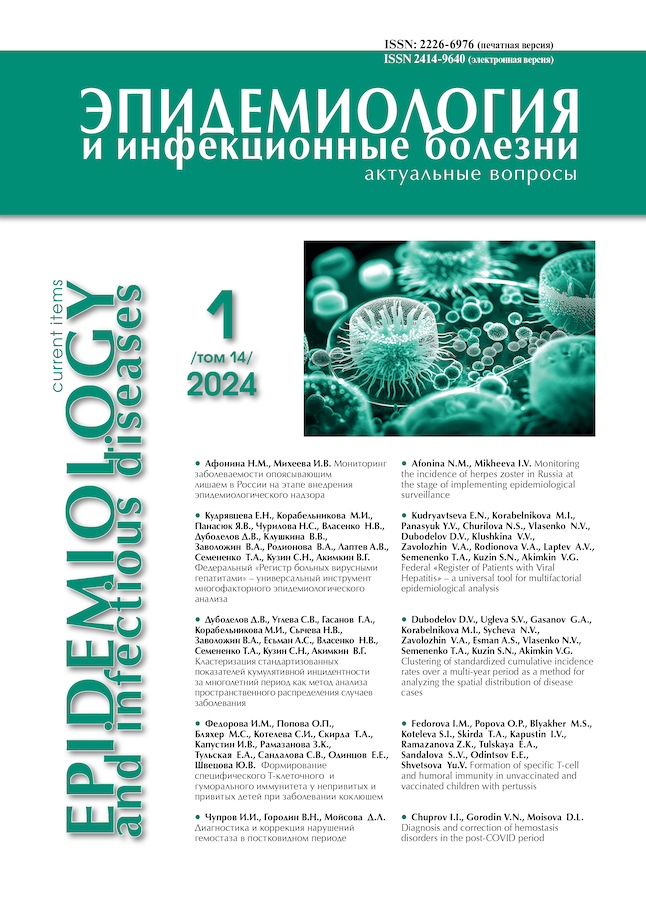Diagnosis and correction of hemostasis disorders in the postcovid period
- Autores: Chuprov I.I.1, Gorodin V.N.1, Moysova D.L.1
-
Afiliações:
- Kuban State Medical University, Ministry of Health of Russia
- Edição: Volume 14, Nº 1 (2024)
- Páginas: 49-54
- Seção: Original Investigations
- URL: https://journals.eco-vector.com/2226-6976/article/view/630517
- DOI: https://doi.org/10.18565/epidem.2024.14.1.49–54
- ID: 630517
Citar
Texto integral
Resumo
Objective. Optimization of diagnosis and treatment of hemostasis disorders in the post-COVID period.
Materials and methods. The study included 100 patients aged 50.5 ± 0.84 years discharged from a COVID hospital 9 months ago. The state of the hemostatic system was assessed after 6 and 9 months after discharge using coagulogram and thrombodynamics test. Depending on the results of the thrombodynamics test in the post-COVID period, patients were divided into 3 groups (A, B, C). Patients in group A (n = 35), with severe hypercoagulation, received rivaroxaban 10 mg per day or apixaban 5 mg per day, patients in group B (n = 45) with moderate hypercoagulation – sulodexide 250 LU 2 times a day, patients of group C (n = 20), with minor changes in hemostasis, did not receive medications. The control group, examined at outpatient settings, included 20 apparently healthy individuals who had not had coronavirus infection (clinically and serologically) and had not been vaccinated against COVID-19. Statistical analysis of the results was carried out in the Statistica version 10 program (StatSoft Inc., USA), using multivariate ANOVA, Kruskal–Wallis test and Spearman correlation analysis.
Results. A hypercoagulable state in the post-COVID period was recorded in 86% of patients. After 3 months in group A, the number of patients with severe hypercoagulation decreased by 2.08 times (from 73 to 35%). Sulodexide was effective in situations with moderate hypercoagulation; in group B, after taking the drug, normocoagulation was observed in 16% of cases.
Conclusion. The data obtained indicate a long-term (more than 9 months) and persistent impairment of hemostasis in the post-COVID period and allows to determine tactics for diagnosing and correcting the prothrombotic state.
Palavras-chave
Texto integral
Sobre autores
Ivan Chuprov
Kuban State Medical University, Ministry of Health of Russia
Autor responsável pela correspondência
Email: chupanya95@mail.ru
ORCID ID: 0000-0001-6164-9995
Full-Time Postgraduate Student, Department of Infectious Diseases and Epidemiology
Rússia, KrasnodarVladimir Gorodin
Kuban State Medical University, Ministry of Health of Russia
Email: vgorodin@mail.ru
ORCID ID: 0000-0003-3062-7595
MD, Pofessor, Head, Department of Infectious Diseases and Epidemiology
Rússia, KrasnodarDiana Moysova
Kuban State Medical University, Ministry of Health of Russia
Email: moisova.di@yandex.ru
ORCID ID: 0000-0003-3920-5997
MD, Associated Professor, Department of Infectious Diseases and Epidemiology
Rússia, KrasnodarBibliografia
- ВОЗ. Клиническое ведение случаев COVID-19. Вариативные рекомендации 25 января 2021 год. https://apps.who.int/iris/ bitstream/handle/10665/338882/WHO-2019-nCoV-clinical-2021.1-rus.pdf
- [World Health Organization. COVID-19 Clinical management: living guidance 25 January 2021]. (In Russ.). https://apps.who.int/iris/bitstream/ handle/10665/338882/WHO-2019-nCoV-clinical-2021.1-eng.pdf
- Giannis D., Allen S.L., Tsang J., Flint S., Pinhasov T., Williams S. et al. Postdischarge thromboembolic outcomes and mortality of hospitalized patients with COVID-19: the CORE-19 registry. Blood 2021; 137(20): 2838–47. doi: 10.1182/blood.2020010529
- Kaseda E.T., Levine A.J. Post-traumatic stress disorder: A differential diagnostic consideration for COVID-19 survivors. Clin. Neuropsychol. 2020; 34(7–8): 1498–1514. doi: 10.1080/13854046.2020.1811894
- Huang L., Li X., Gu X., Zhang H., Ren L., Guo L. et al. Health outcomes in people 2 years after surviving hospitalisation with COVID-19: a longitudinal cohort study. Lancet Respir. Med. 2022; 10(9): 863–76. doi: 10.1016/S2213-2600(22)00126-6
- Yong S.J. Long COVID or post-COVID-19 syndrome: putative pathophysiology, risk factors, and treatments. Infect. Dis. (Lond). 2021; 53(10): 737–54. doi: 10.1080/23744235.2021.1924397
- Von Meijenfeldt F.A., Havervall S., Adelmeijer J.., Lundström A., Magnusson M. et. al. Sustained prothrombotic changes in COVID-19 patients 4 months after hospital discharge. Blood Adv. 2021; 5(3): 756–9. doi: 10.1182/bloodadvances.2020003968
- Görlinger K., Levy J.H. COVID-19-associated Coagulopathy. Anesthesiology 2021; 134(3): 366–9. doi: 10.1097/ALN.0000000000003688
- Patell R., Bogue T., Koshy A., Bindal P., Merrill M., Aird W.C. et. al. Postdischarge thrombosis and hemorrhage in patients with COVID-19. Blood. 2020; 136(11): 1342–6. doi: 10.1182/blood.2020007938
- Iba T., Warkentin T.E., Thachil J., Levi M., Levy J.H. Proposal of the Definition for COVID-19-Associated Coagulopathy. J. Clin. Med. 2021; 10(2): 191. doi: 10.3390/jcm10020191
- Канорский С.Г. Постковидный синдром: распространенность и патогенез органных поражений, направления коррекции. Систематический обзор. Кубанский научный медицинский вестник 2021; 28(6): 90–116. https://doi.org/10.25207/1608-6228-2021-28-6-90-116.
- Kanorsky S.G. [Post-COVID syndrome: prevalence, organ pathogenesis and routes of correction. A systematic review]. Kuban Scientific Medical Bulletin 2021; 28(6): 90–116. (In Russ.). https://doi.org/10.25207/1608-6228-2021-28-6-90-116
- Heesakkers H., van der Hoeven J.G., Corsten S., Janssen I., Ewalds E., Simons K.S. et. al. Clinical Outcomes Among Patients With 1-Year Survival Following Intensive Care Unit Treatment for COVID-19. JAMA 2022; 327(6): 559–65. doi: 10.1001/jama.2022.0040
- Lipets E., Vlasova O., Urnova E., Margolin O., Soloveva A., Ostapushchenko O. et. al. Circulating contact-pathway-activating microparticles together with factors IXa and XIa induce spontaneous clotting in plasma of hematology and cardiologic patients. PLoS One 2014; 9(1): e87692. doi: 10.1371/journal.pone.0087692
- Mansory E.M., Abu-Farhaneh M., Iansavitchene A., Lazo-Langner A. Venous and Arterial Thrombosis in Ambulatory and Discharged COVID-19 Patients: A Systematic Review and Meta-analysis. TH Open. 2022; 6(3): e276–e282. doi: 10.1055/a-1913-4377
- Pretorius E., Vlok M., Venter C., Bezuidenhout J.A., Laubscher G.J., Steenkamp J. et. al. Persistent clotting protein pathology in Long COVID/Post-Acute Sequelae of COVID-19 (PASC) is accompanied by increased levels of antiplasmin. Cardiovasc/ Diabetol. 2021; 20(1): 172. doi: 10.1186/s12933-021-01359-7
- Kell D.B., Laubscher G.J., Pretorius E. A central role for amyloid fibrin microclots in long COVID/PASC: origins and therapeutic implications. Biochem. J. 2022; 479(4): 537–59. doi: 10.1042/BCJ20220016
- Профилактика, диагностика и лечение новой коронавирусной инфекции (COVID-19). Временные методические рекомендации. Версия 17. https://static-0.minzdrav.gov.ru/system/attachments/attaches/ 000/061/254/original/%D0%92%D0%9C%D0%A0_COVID-19_V17.pdf? 1671088207
- Prevention, Diagnosis, and Treatment of Novel Coronavirus Infection (COVID-19). Interim Guidelines. Version 17]. (In Russ.). https://static-0.minzdrav.gov.ru/system/attachments/attaches/000/061/254/original/%D0%92% D0%9C%D0%A0_COVID-19_V17.pdf? 1671088207
Arquivos suplementares











